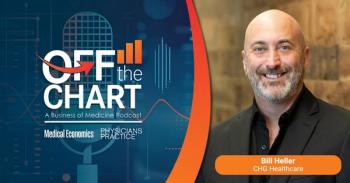
Re-engineering Your Practice: Will all that effort really pay off?
The bottom line is more income, happier patients and staff, and shorter hours for physcicians, say doctors who've adopted the techniques described in this series.
Re-engineering Your Practice
Will all that effort really pay off?
The bottom line is more income, happier patients and staff, and shorter hours for physicians, say doctors who've adopted the techniques described in this series.
By Ken Terry
Managed Care Editor
FP Paul L. Schmidt of Sun Prairie, WI, started re-engineering his practice nearly two years ago. At that time, he had 2,200 patients. Now, he has 2,500, and he gets home earlier most days than he used to. "The person who's really noticed a change is my wife," he says. "She's shocked that I'm home at 5:30."
What made this possible for Schmidt and his seven colleagues at the Sun Prairie Family Practice Clinic was their move to open-access scheduling. Schmidt now sees all patients within two to four days after they call for an appointment, and offers a physical exam within three weeks. Prior to re-engineering, patients waited an average of 19 days to see Schmidt for a nonurgent reason, and 76 days for a physical.
Before the scheduling shift, Schmidt handled a much higher percentage of patients with chronic diseases, because people with other nonurgent problems didn't want to wait so long to see him. Now that access has improved, those patients are coming in. "You can see patients with acute problems much more rapidly than you can see those with chronic problems," notes Schmidt. That allows him to see more people without working longer hours.
Open access and other re-engineering changes have improved the financial basis of his practice, says Schmidt. While he doesn't know how much more he's earning, the Sun Prairie clinic as a whole increased production by 4.3 percent in 1999, and its overall patient count rose by 8 percent.
Sun Prairie is one of 39 practice sites across the country that are participating in a three-year re-engineering project led by the Boston-based Institute for Healthcare Improvement. This program, called the Idealized Design of Clinical Office Practices (IDCOP), has developed practical methods for redesigning office processes rapidly in both large health care systems and small private practices.
Two years into the IDCOP project, average revenue from new-patient visits and mean cost per visit for all patients haven't changed much, says Ann Marie Hess, a senior analyst for IHI. But the average site has halved the number of days that a patient with a nonurgent problem must wait to see a doctor, increasing the capacity to see new patients, she adds. The outpatient clinics of the Cambridge Health Alliance in Cambridge, MA, for example, have increased their primary care base by 12.5 percent in the past year. Appleton, WI-based ThedaCare has seen double-digit increases in income, revenue, and RVU-based production at its two re-engineered sites.
"Those organizations that have tracked their financial course have found that their revenues and margins are higher," says physician Kenneth Smithson, vice president of VHA, a purchasing and consulting organization for more than 2,000 nonprofit hospitals. (VHA provided the seed money for IDCOP, and many of the participating health care systems are VHA members.)
These higher profits, he adds, are being realized despite that fact that the practices are seeing fewer patients. Fewer patients while increasing your patient base? It's not as paradoxical as it seems. Especially in practices that are predominantly fee-for-service, some patients may be seen more often than necessary, while others don't have access to care when they need it. By dealing with as many issues as possible in each visit (known in re-engineering circles as "max-packing"), doing more nonvisit care, and eliminating follow-up appointments for such things as normal lab results, say redesign advocates, practices can serve more patients with fewer visits overall.
Although re-engineering promotes efficiency, none of the practices interviewed for this article has cut staff. The improved financial performance of these groups springs from increased revenues rather than decreased overhead.
This isn't true only of practices that belong to big groups or health care organizations. In 1999, solo internist Allyn M. Norman of Buffalo, NY, received hospital and ancillary surpluses equal to 110 percent of his capitation payments from the HMO that supplies the bulk of his capitated patients. He also got an extra "quality management fee" of $14,000 that was based on the number of patients seen, ER utilization, patient satisfaction, and preventive care. Norman expects this year's compensation to be even better, and he attributes much of his success with capitation to re-engineering.
"For one thing, it's enabled me to monitor a larger panel," he says. "For another, I've kept patients healthier, so they use fewer resources." Norman has measured ER usage, referral costs, and other expense parameters, and they're all decreasing. Much of that, he says, is related to better chronic disease carean effort that's been greatly helped by his creation of registries for patients with conditions like diabetes and hypertension. (For other articles in this series,
New patients are the key to better reimbursement
The key to making re-engineering pay is the ability to increase the capacity of your practice and then serve more new patients, says Anne Marie Hess.
For highly capitated physicians like Norman, this is a no-brainer. It's not so obvious, however, to fee-for-service physicians who are used to bringing back patients frequently, says Hess. "If you clear space in your schedule for new patients, you might produce more revenue than if you churn patients. But seeing new patients is more work initially. So it's a hard sell to get docs to stop churning and open their practices up to new patients."
Other observers agree that churning makes no sense from either a clinical or a financial viewpoint. "Even in fee-for-service, making unnecessary appointments isn't a sound business practice, because it keeps you from growing your patient base," says Anne Gross, an administrator at Cambridge Health Alliance, an integrated delivery system based in Cambridge, MA. "We're still largely fee-for-service. But regardless of the financial implications, it's not good patient care to have patients come back needlessly. You want the patient to get the right level of clinical service."
Somerville, MA, pediatrician David C. Osler, who's employed by Cambridge Health Alliance, welcomes the new business he's generated as a result of going to open access. Osler and his five colleagues at Somerville Pediatrics have unclogged their appointment calendars for new patients partly by dropping what he calls "defensive scheduling." In the past, he explains, nurses would often book follow-up appointments far in advance, just to make sure a slot was open in case a checkup was needed. But under the new scheduling system, the date on which to follow up with a patient is simply entered in the computer; at the appropriate time, a staffer contacts the patient's parent and asks when she wants an appointment for her child.
As a result, says Osler, "we've reduced our no-show rate by one-third to one-half, depending on the doctor. If you have fewer no-shows and you're still booked to see the same number of patients, then you're going to do better financially."
Pulmonary disease specialist Roger K. Resar, who leads the re-engineering effort at the Mayo Health System's Luther Midelfort branch in Eau Claire, WI, admits that his group might be sacrificing some fee-for-service income by becoming more efficient. (Only about 30 percent of Luther Midelfort's revenue comes from capitation.) But by seeing more new patients, he says, the physicians are benefiting economically.
"Because of open access, we've seen production increases ranging between 8 and 14 percent," he reports. "The number of patient encounters doesn't necessarily go up; it may even go down a little. But if you can see new patients instead of seeing old patients over and over, you can code higher for those visits. And that's happening in a lot of our practices."
Open access is only the beginning
Other re-engineering efforts have paid off for Mayo's Luther Midelfort clinic. The behavioral health department, for example, improved its medical record flow by making sure that charts were always in one of two places: on their proper shelf in the record room or in the doctor's hands. The result: Staffers now spend four hours a month looking for charts instead of 80. Between that accomplishment and some efficiencies achieved in the transcription area, the department reduced its staff needs by the equivalent of two full-time employees. Instead of laying off two workerswhich would have damaged staff moralethe department began selling their time to other divisions.
Luther Midelfort is also using group visitsanother re-engineering techniqueto cut costs and improve outcomes. Group sessions for depression, for example, are conducted by psychologists or other therapists, with a psychiatrist attending as a backup. The doctor is also there to prescribe the medications that accompany cognitive therapy. "The outcomes are as good as or better than any national benchmarks," says Resar.
The group sessions, he notes, have enabled the psych department to double its income from depression treatment. Both Medicare and commercial carriers pay for group visits for mental health patients. Insurers are even starting to cover group sessions outside behavioral health, Resar adds.
While group visits are a bit advanced for many physicians, they exemplify one use of "care teams" that help physicians handle enlarged patient loads. At its extreme, this approach has enabled some doctors to juggle panels of up to three times normal size. Internist Allyn Norman, for instance, takes care of 6,250 patients with the aid of one nurse practitioner and several other staffers.
Other practices are using care teams to accommodate modest increases in their panels. Usually, this means morning "huddles" to prepare for the day's booked patients. "Every day, my health assistant and I look at who's coming in that day and what she might do ahead of time," says David Osler. "That's very helpful."
To distribute the workload better, adds Osler, the practice has taken steps to ensure that all clinical staffers "are working up to their capacity or competence." For example, the nurses are now doing immunizations, which frees the physicians to do other things.
Some doctors are also using re-engineering to improve patient flow in other ways. For instance, in the Dean Health System of Madison, WI, which includes FP Paul Schmidt's clinic, some practices use multicolored flags outside exam rooms to let doctors know when a patient is in a room or whether he's the next patient to see. When the physician leaves an exam room, he might put out a red flag to let the nurse know she needs to set up the patient for a procedure. "It used to be very inefficient when the patient would stand in the hall and wait for the nurse to come out of the next room," says John Otterson, a practice management specialist at Dean. "So we've improved flow that way, and it's a pretty fundamental change."
It's hard to measure the financial impact of streamlining clinical workflow. But patients are clearly more satisfied when they're able to spend less time at the doctor's office. The average length of time a patient spends in pediatrician David Osler's office has dropped from 55 to 35 minutes. At Fairport Internal Medicine in a suburb of Rochester, NY, average time in the office for patients has plummeted to just 22 minutes.
The biggest obstacles to re-engineering, says Ann Marie Hess of IHI, are weak leadership and physicians' resistance to change. "Most of the leaders in our practices don't stand up and say, 'It won't be easy, but we're going to open-access scheduling.' It takes a leader who will put a stake in the ground, even if some people will leave."
It also takes money to get started. The major expenses involved in re-engineering are extra pay for staffers to help physicians work down their appointment backlog so they can implement open-access scheduling, the hiring of additional medical records staff in some practices, and the dedication of some physician time to redesign work.
Will re-engineering pay off financially? Physicians engaged in re-engineering say Yes, but that isn't their only concern. "I've increased the happiness of my patients and the reputation of our clinic," says FP Paul Schmidt of Dean. "Those are things you can't measure in dollars."
This is the last installment in our series looking at how doctors are re-engineering their practices. Below is a complete list of the previous articles in the series. You can also find the articles on our Web site,
"
"
"
"
"
"
"
"
"
"
"
Ken Terry. Re-engineering Your Practice: Will all that effort really pay off?. Medical Economics 2000;24:81.
Newsletter
Stay informed and empowered with Medical Economics enewsletter, delivering expert insights, financial strategies, practice management tips and technology trends — tailored for today’s physicians.








